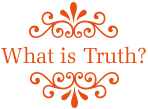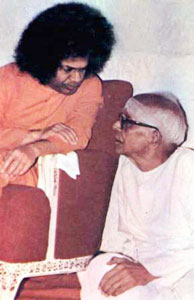 |
 |
 |
| Volume
3 - Issue 5 MAY 2005 |
What is Truth?
Pilate did not wait for an answer from Jesus. Alas! The pity of it! Jesus knew himself as the Way, the Truth and the Life. Instead of learning from Jesus what he had come to teach, Pilate went out again to the Jews who were clamouring to have Jesus crucified. THE
OATH Truth too delights in the game of hide and seek. It revels in camouflage and masquerade. The real and the genuine challenge our faculties to the utmost, for they appear only as we desire, decorated, modified or moulded in order to flatter our likes and dislikes. No wonder, an aspirant for experiencing the Truth bewailed, as the Veda records, "What thing I am I do not know. I wander alone burdened with my mind." The mind squirts its ink of aversion or attachment, avarice or anxiety on whatever he prefers as Truth. Swami declares, "The know¬ledge of the Truth is acquired by unin¬terrupted inquiry by the clarified intellect and purified mind." PURIFIED
MIND? There is another equally deluding factor—the needs and beliefs of the others amidst whom we have to grow. We are "cultured" into accented and respected patterns of action and reaction, analysis and synthesis, ideas and ideals. We are conditioned so much by the invi¬dious forces of social approval that we imbibe and implement, customs and conventions, frills and fashions, models and maps, idioms and idols, do's and don'ts bwhich are prescribed or proscribed by 'public opinion'. CLARIFIED
INTELLECT? Much depends on the integrity of the person who utters and on the Intelligence of the listener. But even when both are so equipped, if they are yoked to a language in which sublime spontaneous experiences are not expressible through distinct words or through pre¬fixes and suffixes, prepositions and pa¬raphrases, it becomes difficult to have them stamped on the memory for recapi¬tulation and reflection. This defect was noticed centuries ago by the sages of the Upanishad texts. The Brihadaaranyaka Upanishad, while di¬lating on Sathya Vidya, the process of meditating on Brahman (the Absolute) as Sathyam (Truth) reveals that the word Sathyam is a tri-syllable. Sa thi yam—"The first and last syllables are Truth; in the middle is falsehood (anrtham), Falsehood is embraced by Truth; thereby, it partakes of the nature of Truth." THE
MIRAGE Einstein has told us, "Whoever undertakes to set himself up as judge in the field of Truth is shipwrecked in the laughter of the gods.” The Vedic Hymn laments: Who
really knows? Who can presume to declare? A
HUNDRED ANSWERS The path to Truth is paved with discarded certainties. The level of moral purity, mental clarity, intellectual verity and emotional stability decide the Truth we can rely upon. When the horizon wi¬dens, the waves subside and the storms are stilled, more facets of Truth come within our reach. Our minds with their numberless preferences and prejudices, desires and designs, befog the Truth in order to please our passing fancies. This diversionary strategy stunts our intellect and stultifies our intuition. So, we have to grope for Truth in the wilderness of a vast "Perhaps". Indeed, we have in India an honest and honoured school of sceptic metaphysics named Syad Vada, which professes and propagates its view of Truth as 'may be', ‘perchance', 'perhaps'! This Syad Vada appears as legitimate. Therein, the innate incomprehensibility of "the Truth, the whole Truth and nothing but the Truth" is demonstrated by seven steps of an astonishing logic of possibilities, the Saptha Bhangi Nyaya, which debunks the idea of finality: (1) Syad asthi (perhaps, it exists) (2) Syad nasthi (perhaps, it does not exist); (3) Syad asthi cha, nasthi cha (perhaps, it exists and does not exist); (4) Syad avakthavyah (perhaps, it is indescribable); (5) Syad asthi cha avakthavyah (perhaps, it exists though indescribable) ; (6) Syad nasthi cha avakthavyah cha (perhaps, it does not exist and is indescribable) ; (7) Syad asthi cha, nasthi cha avakthavyah cha (perhaps, it exists and does not exist and is indescribable). NO
SCEPTICISM In spite of this indeterminism, incomprehensibility and his own incompetence, man is persistently urged by an inner hunger for Truth, an inner Voice that prods him to Arise, Awake and receive instruction from the Masters. He pleads "Lead me from the unreal to Reality: lead me from darkness to Light; lead me from death to Deathlessness." When the hunger is tolerated, dismissed or suppressed and when the Voice within is jammed or joked about, the Master, the Swami presents Himself as Teacher to guide Man to his Truth. "Human ness and God ness, the Role and the Reality co exist inseparably in every one of you," Swami told a gathering of students in 1974. "They are the negative and the positive, which, to¬gether produce the warmth of Love, of light, of Wisdom. Once you establish yourselves in the awareness of Reality, you can wander safe and free in the alleys of the Apparent." GOD
IS THE TRUTH Countless numbers of pilgrims and pupils have criss-crossed the earth, along its highways and bye-ways, in search of Truth, the Truth of themselves and of the scenario and struggle into which they have been thrust. The trek of patients in search of cures towards the doors of the wise has continued throughout history. Man can find no peace until he understands the Truth of whatever arou¬ses wonder, awe, sympathy, reverence, curiosity and fear. He strives for unity and coherence, harmony and beauty. He wants to know things as they really are, not as they seem to be or pretend to be. Luckily, there is a bright side to the story of man's journey to Truth. Prophets, sages and saints, Masters and Messengers, have appeared among all peoples and taught men by precept and example the Truth that can free them. The Cosmic Consciousness itself, when it becomes aware of its fragments getting fogged and frustrated, wills to shape Itself into a Form that can move among men and move them Home towards Itself. Such a Form is known as an Avatar, a particularisation of the Absolute. The Avatar happens in order to fulfill a felt need and so, it’s Wisdom, Love, Power and Com¬passion pour over all who need them. All men, indeed all living beings, are its concern. And, ' lifeless' matter too. For, as Swami says, Sarvam Brahmamayam, everything has emanated from Brahman, the vast Ocean which emanates ripples, wavelets, waves, foam and flakes of snow and icebergs. The Atom is a replica of the Cosmic energy; cell is an echo of Cosmic will. "Vasudeva is all," the Gita declares, without exception. The Rig Veda proclaims, "All this is Purusha himself, all that has been and all that is going to be." This is the Truth. The Rudra Adhyaya of the Yajur Veda commands man to adore 238 representative entities of God, illustrating thereby that there is nothing except God. (The Katha Upanishad condemns those who see the Cosmos as manifold and not as basically Brahman; they have to plod through life after life until they realise the error). Rudra, the name assigned to God, is described in the Vedic texts as the motivator seated in all hearts, as the provider, the saviour of the Universe which is His self assumed form. He is identified with the chiefs, the middlings and the lowly, the tall, the short and the stout, the aged, the young and the juvenile, the wise, the curious and the dull, and the sleepy. He is stone, sand and dust, slush, pollen and gravel, ripple, foam and wave, river, stream, lake, and canal, lightning, cloud, shower and rain, ocean, island and shore. Rudra is the highway, the road, the track. He is the sprout, the shoot, the leaves, the pests, the birds with throats blue and yellow, the tree and the timber. He is the one engaged in trading or farming or rearing cattle. He is the cow pen and the crop, the food and the cook. He is the man behind the plough on fertile land or barren. He is the person who is brave and fearsome, fighting from trenches and on open fields, with missiles, arrows, spears and swords. He is the warrior who revels in duels, who moves forward in chariots with helmet and coat of mail. He is the foot soldier, the horseman, the leader of dogs and the led. He is the scout, the messenger, the smith, the carpenter, the hunter, the wily guerilla, the cheat and the dacoit, the decoy and the impersonator. Rudra is in the form of the monk, the cave dweller having a crown of matted hair, the one who has mastered the steady pose, the sage who has crossed over and who leads others across, the elderly scholar, the dialectician delighting in debates, the Vedic expert and the master of rituals. He is the person who is compassionate, sweet and tender. In fact, God is the warp and woof, the cotton and yarn, of the fabric, apparent to us as the Universe. That is the Truth which is encased in every cell and star. —Late
Prof N. Kasturi, |
| Optimized for Netscape and Firefox. Best viewed in Internet Explorer - 1024 x 768 resolution. |
 "You
are a King, then?" said Pilate. Jesus answered, "'King'
is your word. My task is to bear witness to the Truth. For this was
I born; for this I came into the world, and all who are not deaf to
Truth listen to my voice." Pilate said, "What is Truth?"
And, with those words, went out again to the Jews.
"You
are a King, then?" said Pilate. Jesus answered, "'King'
is your word. My task is to bear witness to the Truth. For this was
I born; for this I came into the world, and all who are not deaf to
Truth listen to my voice." Pilate said, "What is Truth?"
And, with those words, went out again to the Jews.